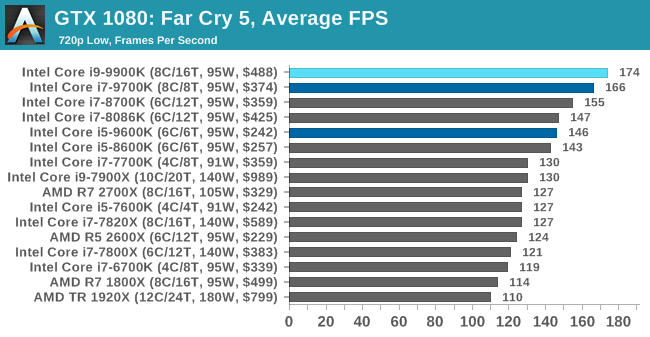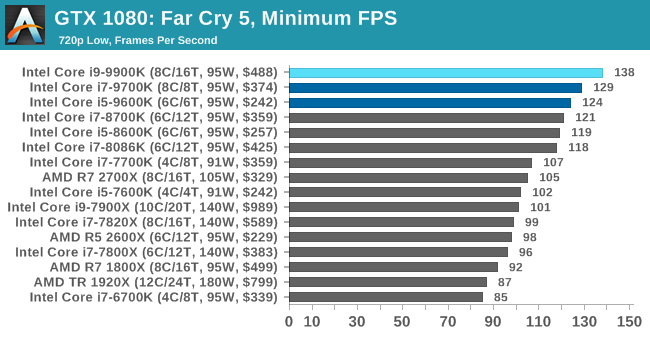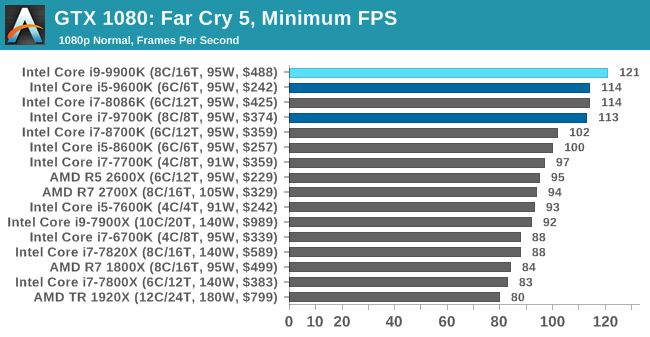The Intel 9th Gen Review: Core i9-9900K, Core i7-9700K and Core i5-9600K Tested
by Ian Cutress on October 19, 2018 9:00 AM EST- Posted in
- CPUs
- Intel
- Coffee Lake
- 14++
- Core 9th Gen
- Core-S
- i9-9900K
- i7-9700K
- i5-9600K
Gaming: Far Cry 5
The latest title in Ubisoft's Far Cry series lands us right into the unwelcoming arms of an armed militant cult in Montana, one of the many middles-of-nowhere in the United States. With a charismatic and enigmatic adversary, gorgeous landscapes of the northwestern American flavor, and lots of violence, it is classic Far Cry fare. Graphically intensive in an open-world environment, the game mixes in action and exploration.
Far Cry 5 does support Vega-centric features with Rapid Packed Math and Shader Intrinsics. Far Cry 5 also supports HDR (HDR10, scRGB, and FreeSync 2). We use the in-game benchmark for our data, and report the average/minimum frame rates.
| AnandTech CPU Gaming 2019 Game List | ||||||||
| Game | Genre | Release Date | API | IGP | Low | Med | High | |
| Far Cry 5 | FPS | Mar 2018 |
DX11 | 720p Low |
1080p Normal |
1440p High |
4K Ultra |
|
All of our benchmark results can also be found in our benchmark engine, Bench.
| Far Cry 5 | IGP | Low | High |
| Average FPS |  |
 |
 |
| Minimum FPS |  |
 |
 |
Far Cry 5 is another game that at reasonable 1080p settings actually shows some CPU differentiation. To really drive a wedge between the CPUs we do need to drop to 720p Low, but still, in both cases the 9900K comes out on top. And in this case the performance gap between it and the 8700K is actually a bit larger than normal at 12%. Still, this is a game that’s if it’s not GPU-bound is closer to being bounded by a limited number of threads, so the lack of major clockspeed gains for the 9900K keep it from pulling too far ahead. It also keeps the 9700K from falling too far behind.












274 Comments
View All Comments
Total Meltdowner - Sunday, October 21, 2018 - link
Those typoes.."Good, F U foreigners who want our superior tech."
muziqaz - Monday, October 22, 2018 - link
Same to you, who still thinks that Intel CPUs are made purely in USA :DHifihedgehog - Friday, October 19, 2018 - link
What do I think? That it is a deliberate act of desperation. It looks like it may draw more power than a 32-Core ThreadRipper per your own charts.https://i.redd.it/iq1mz5bfi5t11.jpg
AutomaticTaco - Saturday, October 20, 2018 - link
Revisedhttps://www.anandtech.com/show/13400/intel-9th-gen...
The motherboard in question was using an insane 1.47v
https://twitter.com/IanCutress/status/105342741705...
https://twitter.com/IanCutress/status/105339755111...
edzieba - Friday, October 19, 2018 - link
For the last decade, you've had the choice between "I want really fast cores!" and "I want lots of cores!". This is the 'now you can have both' CPU, and it's surprisingly not in the HEDT realm.evernessince - Saturday, October 20, 2018 - link
It's priced like HEDT though. It's priced well into HEDT. FYI, you could have had both of those when the 1800X dropped.mapesdhs - Sunday, October 21, 2018 - link
I noticed initially in the UK the pricing of the 9900K was very close to the 7820X, but now pricing for the latter has often been replaced on retail sites with CALL. Coincidence? It's almost as if Intel is trying to hide that even Intel has better options at this price level.iwod - Friday, October 19, 2018 - link
Nothing unexpected really. 5Ghz with "better" node that is tuned for higher Frequency. The TDP was the real surprise though, I knew the TDP were fake, but 95 > 220W? I am pretty sure in some countries ( um... EU ) people can start suing Intel for misleading customers.For the AVX test, did the program really use AMD's AVX unit? or was it not optimised for AMD 's AVX, given AMD has a slightly different ( I say saner ) implementation. And if they did, the difference shouldn't be that big.
I continue to believe there is a huge market for iGPU, and I think AMD has the biggest chance to capture it, just looking at those totally playable 1080P frame-rate, if they could double the iGPU die size budget with 7nm Ryzen it would be all good.
Now we are just waiting for Zen 2.
GreenReaper - Friday, October 19, 2018 - link
It's using it. You can see points increased in both cases. But AMD implemented AVX on the cheap. It takes twice the cycles to execute AVX operations involving 256-bit data, because (AFAIK) it's implemented using 128-bit registers, with pairs of units that can only do multiplies or adds, not both.That may be the smart choice; it probably saves significant space and power. It might also work faster with SSE[2/3/4] code, still heavily used (in part because Intel has disabled AVX support on its lower-end chips). But some workloads just won't perform as well vs. Intel's flexible, wider units. The same is true for AVX-512, where the workstation chips run away with it.
It's like the difference between using a short bus, a full-sized school bus, and a double decker - or a train. If you can actually fill the train on a regular basis, are going to go a long way on it, and are willing to pay for the track, it works best. Oh, and if developers are optimizing AVX code for *any* CPU, it's almost certainly Intel, at least first. This might change in the future, but don't count on it.
emn13 - Saturday, October 20, 2018 - link
Those AVX numbers look like they're measuing something else; not just AVX512. You'd expect performance to increase (compared to AVX256) by around 50%, give or take quite a margin of error. It should *never* be more than a factor 2 faster. So ignore AMD; their AVX implementation is wonky, sure - but those intel numbers almost have to be wrong. I think the baseline isn't vectorized at all, or something like that - that would explain the huge jump.Of course, AVX512 is fairly complicated, and it's more than just wider - but these results seem extraordinary; and there' just not enough evidence the effect is real, not just some quirk of how the variations were compiled.